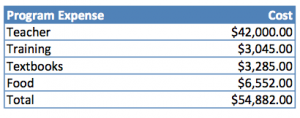Who Pays For Charter Schools And How?

PBS
If you look carefully in the upper left hand corner of the image, you can actually see SimSchool. Also, if you click on this photo, you can play SimCity. (Requires Internet Explorer)
As students head back to the classroom this year, many are starting at charter schools, an education option that’s become increasing popular in recent years for parents who want a choice in where they send their kids. But not all charters are created equal, and sometimes that disparity comes because of funding differences.
A few weeks ago, we brought you SimSchool. This was a hypothetical charter school which we created and brought before the chartering officials at Ball State University. In that story, we told you all about the hidden costs of starting a new charter school. Now, a look at what it takes to fund a new charter school:
1. Tuition Support
Under new legislation passed during the most recent session of the Indiana State General Assembly, the single largest source of revenue for a charter school is students. Each student is allocated a base amount of about 46 hundred dollars from the state whether they attended a traditional public school or a charter school. Officials with Ball State’s Office of Charter Schools say the ideal number of students is between 250 and 300. Schools with an enrollment in this range are hitting a sweet spot when it comes to maximizing dollars per student. This can be a problem for schools in areas with low population density, where public schools may have fewer than 150 students. These charters could have a difficult time syphoning off enough students to make the school sustainable.
2. Start-Up Grants
Both state and federal departments of education offer start-up grants to new charter schools looking for that initial funding needed to procure and renovate a building, establish a curriculum, hire and train teachers, buy furniture and equipment and just generally get the ball moving. While these grants can total a substantial amount of money, in some cases, as much as two million dollars, this funding is usually only available for a school’s first two years of existence and often comes with a number of restrictions. Usually, these funds are distributed based on a school’s need and enrollment.
3. Categorical Grants
This is the single most complicated form of revenue in both traditional public and charter schools. These grants cover extremely specific program cost. In Indiana, for example, there are grants to cover vocational programs, special education expenses, full-day kindergarten, honors classes, and an enormous variety of other expenses.

Here is a break down of the major expenses involved in running a kindergarten program. SimSchool's full day kindergarten grant falls about 5 thousand dollars short of covering all of the programs costs.
This can get confusing. For one thing, grants rarely pay the full amount of a program. In the case of full day kindergarten, SimSchool qualified for about 50 thousand dollars in full day grant funding. Hiring a full time teacher to teach this class cost more than 42 thousand dollars in salary alone. This means that accepting or applying for a grant involves making a long term commitment to a program which could cost more than the value of the award. In some case, turning a form of revenue into an expense.
Many charter schools also receive money through the federal Title 1 program. The amount of this funding is based on the total number of students in either special education or on free and reduced lunch.
4. Charity
Sometimes, this comes in the form of large contributions from enormous endowments like the Bill and Melinda Gates Foundation. In other cases, charity comes in the form of in kind donations like materials, supplies or even basic services. One real charter school, Rural Community Academy in Greysville, Indiana, depends extensively on volunteers to mow the lawn, make basic repairs, and do some of the cleaning.
In rural areas, fundraising can be a problem because there is a much lower concentration of charitable money available. This means charter schools in these areas are extremely dependent on donations of resources and labor. In some cases, rural schools even count on volunteers to provide what many would consider basic classroom programing like teaching music and art.
The last major source of charitable donation comes in the form of what is called credit enhancement. There are a number of large organizations which will cosign on loans, so that charters can borrow whatever additional funding the school might need.
Revenue was a persistent problem in the creation of SimSchool. Because of the splintered nature of many of grants and awards, we often found ourselves in a situation where we had too much money funding one program, while we were having to borrow to fund another expense. At the same time, we were force to make many choices when it came to accruing debt. Do we take out a mortgage so that we can pay for our school building over time or do we completely drain the coffers our first years and hope that we raise enough money to stay open our second year. There are many different approaches to these problems, but underlying it all are the same basic pools of resources. The biggest challenge comes in constantly searching for a way to make ends meet.
